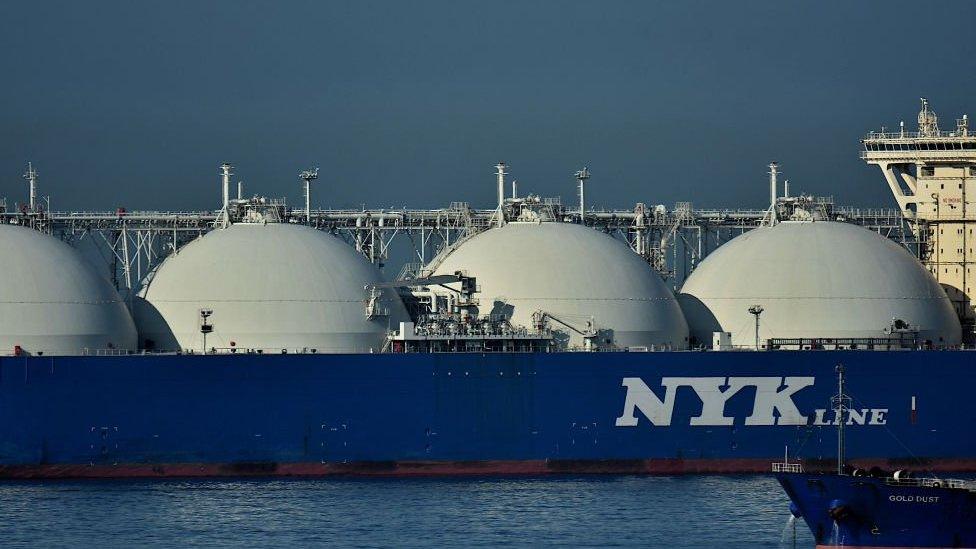Oil fights to retain its licence to drill
- Published

It's a year since oil and gas prices spiked. Oil is on the way up again, but governments, producers and traders have learned to cope with volatile markets following Russia's invasion of Ukraine.
As the offshore energy industry gathers in Aberdeen, fossil fuel drillers are fighting for a future in UK waters, saying £100 billion of investment is at stake while it seeks political commitment and support.
This formidable lobbying operation is a political battle over climate change, energy security and jobs.
As if attendees need reminding at the enormous Offshore Europe event in Aberdeen this week, prices can go up as well as down. And they're on another Brent crude rollercoaster.
The globally-recognised benchmark cocktail of crude oil from several North Sea fields dropped a dollar on the event's first day, then surged three dollars to $91 per barrel. It's at its highest level since last November.
In the past three months, the spot crude price is up 16%, and futures by 20%. Along with the pound weakening against the dollar since July, it's feeding through to higher prices for petrol and diesel.
A litre of petrol is up in only a month from £1.45 on average to £1.52 - the fifth largest monthly rise in 23 years.
Why? The market reacts to constraints on supply, with Saudia Arabia and Russia saying they will keep the taps turned down for a further three months in order to keep prices up. That takes us into the winter market, when energy demand can go up.
On the supply side of the oil market, while prices have been subdued by some expectations of weak economic figures from the US to China meaning weak demand for oil, more recent data have pointed to demand strengthening. Energy traders are saying the Brent crude bench mark could be around $95 by the end of the year.
Asian competition
All this looks a lot more subdued than it did last summer. August 2022 saw the peaks of prices for oil and gas. Six months into Russia's invasion of Ukraine, bringing severe disruption to supply, traders rushed to secure supply for last winter.
They succeeded. Europe's and the US's storage was filled ahead of target, and winter turned out to be mild, meaning less fossil fuel is burned.
This winter remains a concern for energy planners, because much depends on temperatures. But markets have had 21 months to adapt to the new geo-politics of sanctions against Russia, and to pricing with that new source of volatility.

Gas is increasingly transported by ship in the form liquefied natural gas (LNG)
The price of natural gas has fallen and stabilised far more than anyone could have foreseen a year ago. It now trades around double the trend price before August 2021, when Russia began its squeeze on supply and prices began to rise. But the current price is far below the sky-high spikes seen last summer. For oil, at $90 per barrel, that is a welcome relief for energy users from the $120 peak, and the £2 litre of diesel.
As we're seeing with oil this week, however, it doesn't take much to unsettle global markets. Britain used to source its gas through pipelines from entirely predictable suppliers, mostly in the North Sea.
It now buys Liquified Natural Gas (LNG) on the world market, carried on tankers from the Persian Gulf and the USA, and has to compete for tanker-loads with Asian customers. So the threat of a gas drillers' strike as far away as Western Australia, choking off China's supply of LNG gas, has been raising fears of a supply shock in Asia, affecting prices in the UK and Europe.
Awaiting sign-off
In Aberdeen, at the P&J Arena, venue for Europe's biggest offshore energy gathering this week, higher prices should be good news, meaning more profit on existing production and more investment projects get over the line for approval.
But that's not how it's working out in the UK North Sea. Offshore Energy UK (OEUK), representing oil and gas producers and part of the renewable energy sector, has published a report that says a vast amount of investment is ready for that Final Investment Decision, but it's not getting approved.
It calculates there is £200bn could be invested over the next ten years, in both renewable and fossil fuel drilling. Half of that is awaiting sign-off.
Oil and gas is getting up to £4bn investment this year - lower than expected because of slow approvals, and less than recent years in real terms due to cost inflation.
A further £35bn in fossil fuels could be invested over the next ten years, half in existing fields and half in new ones. But 70% of that investment is "yet to be secured".
Over those 10 years, the expectation is of £70bn in production costs and £20bn in decommissioning of retired equipment.
Battle for survival
The industry grouping claims these investment decisions need a stronger business environment for regulation, planning approvals, grid connection consents, licences to explore and produce, the tax regime and government stability. In addition, they face higher financing costs than they did when these projects were in the planning pipeline.
The context for this is the turf chosen by Labour and Conservatives to differentiate their approach to climate change and energy security - Labour wanting to stop handing licences for further exploration or production, Conservatives wanting to accelerate that process, and the SNP leadership meanwhile arguing for a higher environmental hurdle for producers to clear.

Climate change activists have demanded an end to the issuing of new exploration and production licences
The industry body's annual economic report is usually a sober assessment of its value in jobs, tax paid and the pipeline of projects to keep the industry thriving. It's a statement of progress and of intention.
It doesn't read that way in 2023. The document is a hard-argued plea with governments and opposition for the industry's survival. It is seeking backing for further investment and to maximise domestic production at a time of international volatility.
In graphs and stats, it sets out the trajectory for Britain's energy use in the coming decades, and how much of that will continue to be from oil and gas, even if those net zero targets are achieved.
The story since the turn of the century, as UK production peaked, is of 70% decline in production but only 28% decline in demand. The UK has gone from net exporter to net importer, in a big way.
'We need consensus'
OEUK seeks to explain that offshore fields are draining fast, and replacing that production will require further field extensions or new fields to open up. Twenty fields are due to retire this year, with only two opening.
Of 283 fields in production this year, more than 180 are expected to stop producing this decade. These ageing fields produced 45% of UK oil and gas output last year.
The report warns: "The impacts of these trends are already being seen in production. Output in the first five months of this year was down by a tenth from the same period last year (6% decline in gas production and 12% for oil) and down by a fifth from 2018.
"This is double the rate of decline in oil and gas consumption, leaving the country relying on net imports for around one-third for oil and just over half for gas."
OEUK adds the employment case: 220,000 jobs directly and indirectly employed by oil companies, 93,000 of them in Scotland.

OEUK boss David Whitehouse wants more consensus on how the industry handles the transition to net zero
Comments from David Whitehouse, chief executive of OEUK, reflect deep frustration that the industry has moved to the centre of the battle for power at next year's election between Conservatives and Labour.
"The transition to net zero will be the biggest engineering project this country has ever seen," he says. "We need consensus to support the very industries and workers whose skills are vital for building our energy future.
"In recent months we have felt the direct impact of underinvestment in homegrown energy on job security for our workers, the competitiveness of our firms internationally and our future energy bills.
"Our report shows that with the right frameworks in place, this industry can make the long-term investments to help the UK tackle these challenges head-on.
"As the global race for energy investment accelerates, the UK must compete by making the most of its diverse homegrown industry, from oil and gas to offshore wind, hydrogen and carbon capture. Globally, this is the lesson other countries have learnt. We must not get left behind."
Social licence
One big question is not whether Britain's oil and gas industry is in decline, but how fast it is allowed or forced to decline. In terms of barrels of oil or their gas equivalent (boe), 45 billion have been extracted since the Queen pressed the button on the Forties field in 1975.
The industry estimate is of up to 10 to 15 billion remaining, but only around 8 billion of these being technically and financially viable. But if there's a loss of investor confidence, OEUK foresees less than 4 billion being pumped - around quarter of the demand forecast through to 2050.
A further question is how fast renewable energy can replace it when it, too, faces planning and consenting obstacles, a different windfall taxand and the higher cost of finance. And a third question is how willing Britain is to rely on imported energy.
Any other industry that ensured domestic production of a vital strategic resource, at a time of growing geo-political tension, could expect to be given an easy time by government.
But not while there's another battlefront, over climate change. And not when that industry does not protect resources for the UK, but sells them for the best price it can achieve on the global market.
The industry's critics - and there are many of them, opposed to its high profits and to the climate damage done by its products - will be happy to see it on the back foot like this.
They can produce graphs and stats that show the climate implications of continuing to produce and burn further reserves of fossil fuels.
Armed with data on climate change, they have pushed the energy giants into the centre of the political arena, and forced them to fight - not just for exploration and production licences, but for their social licence to keep drilling.
